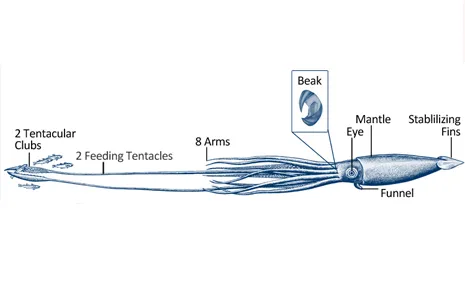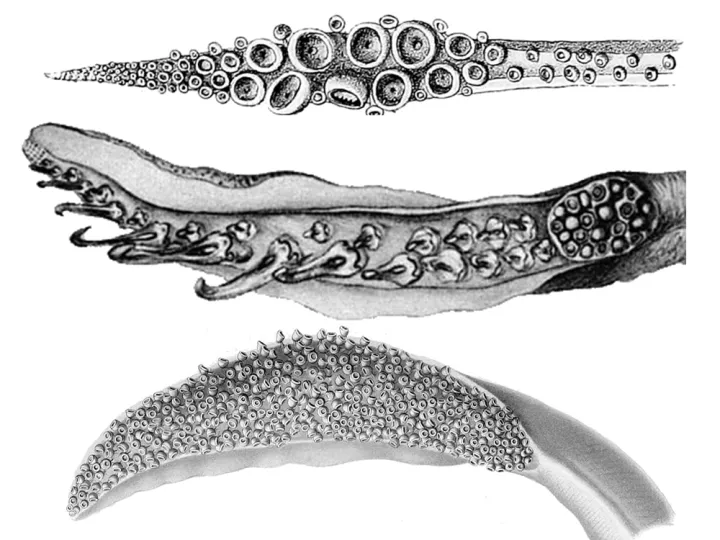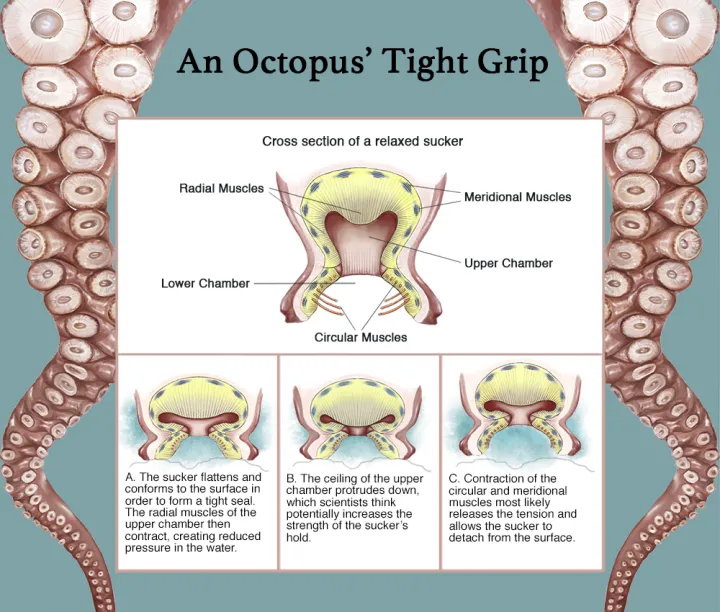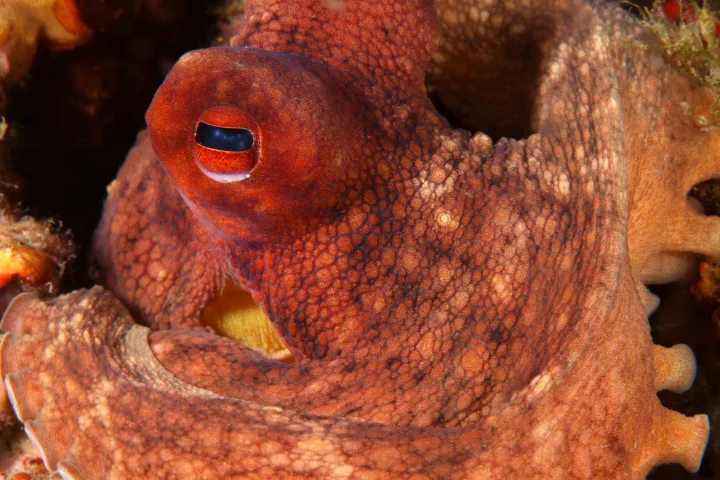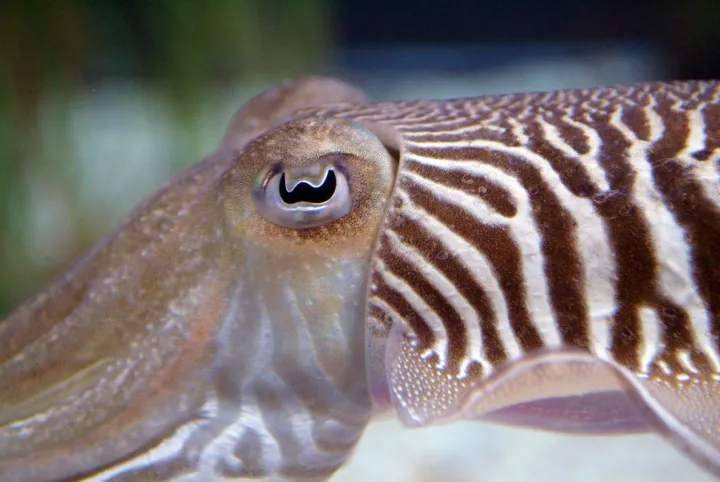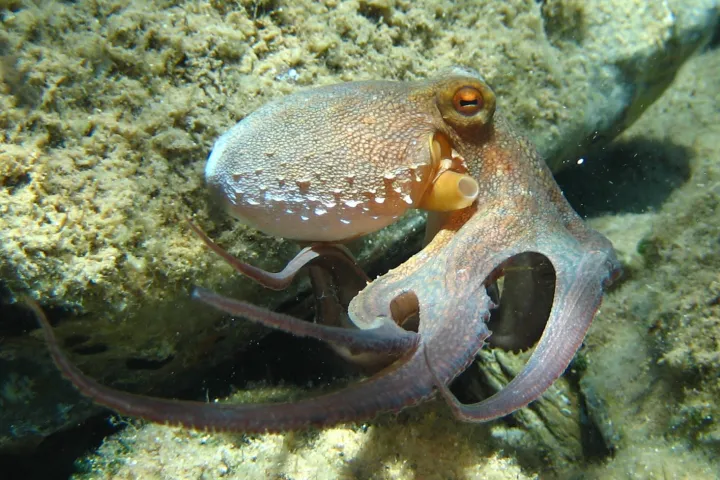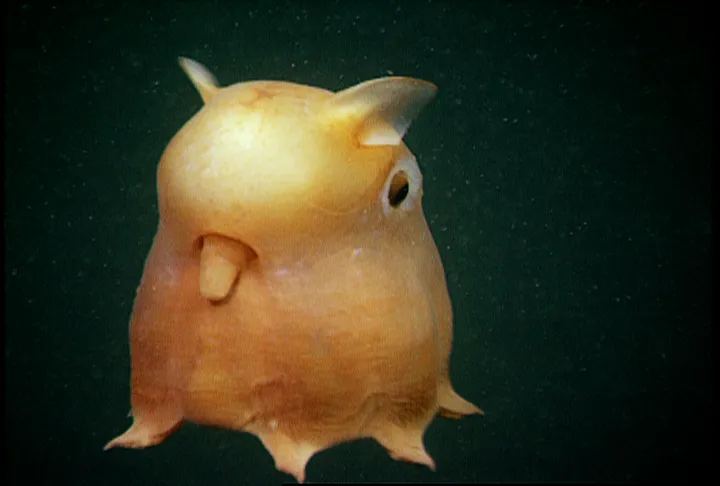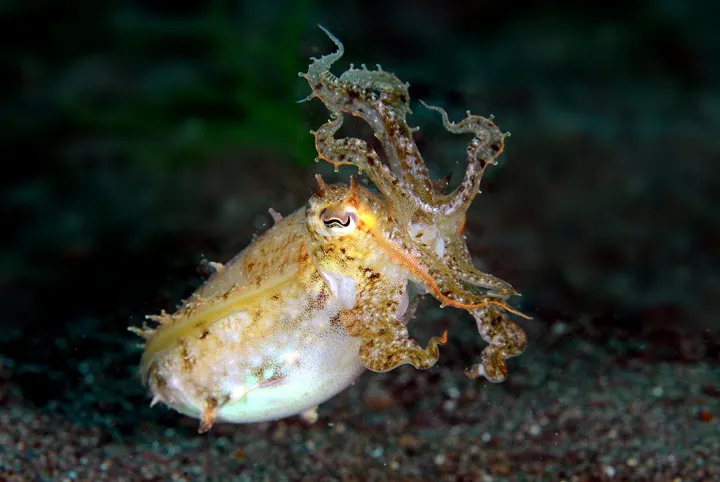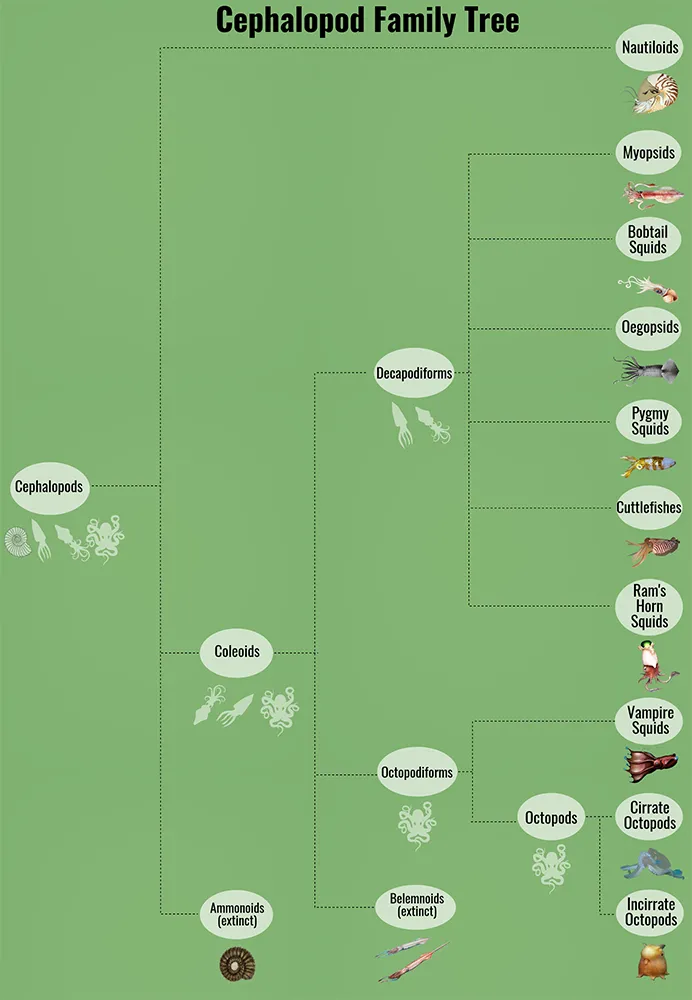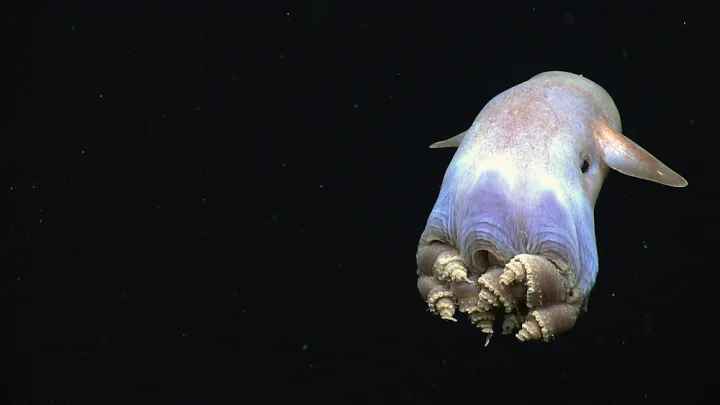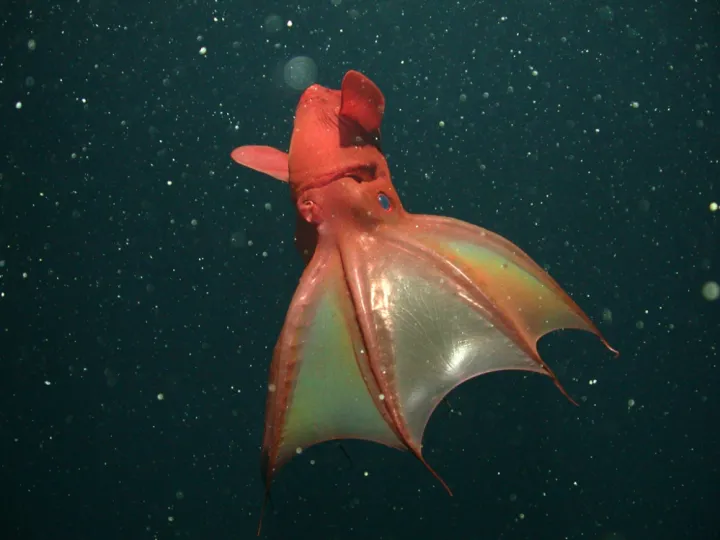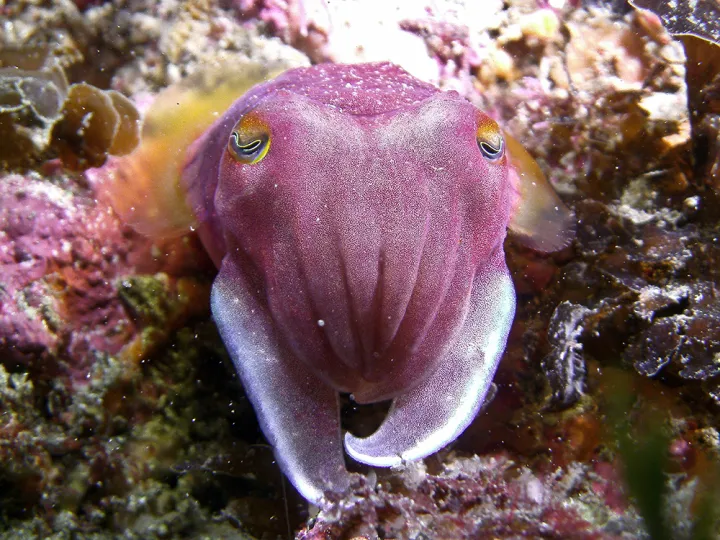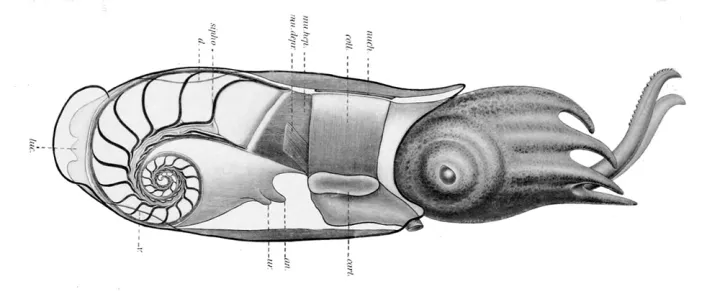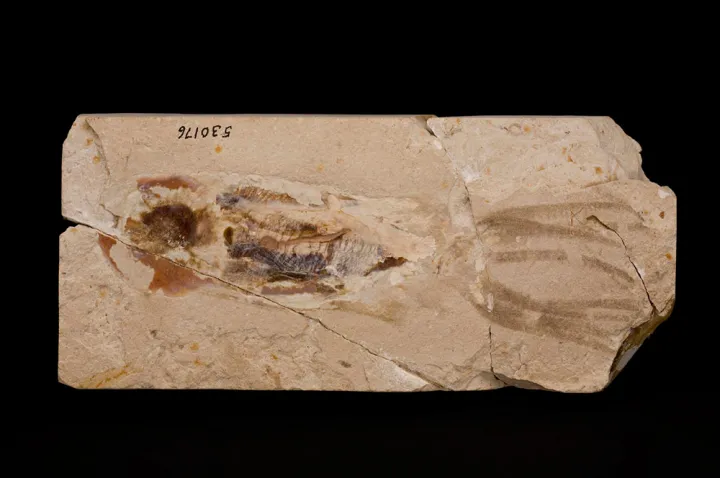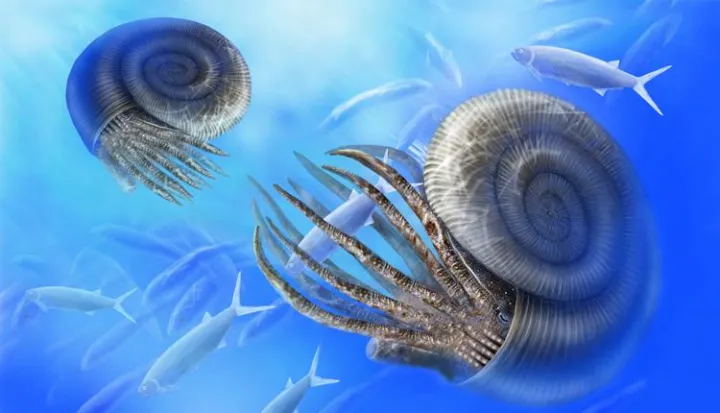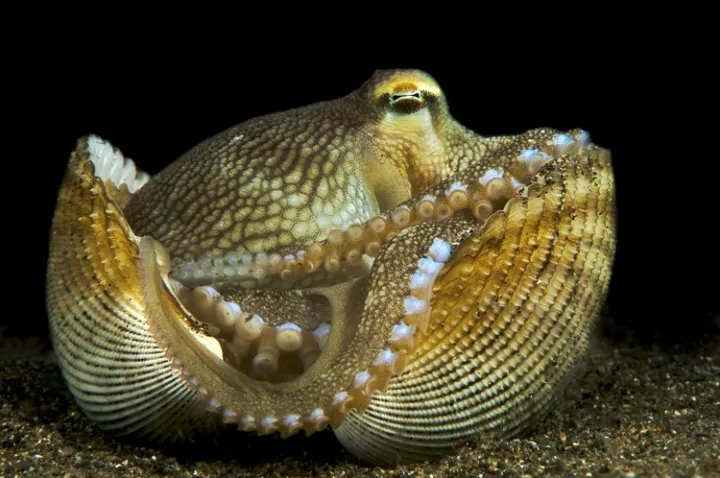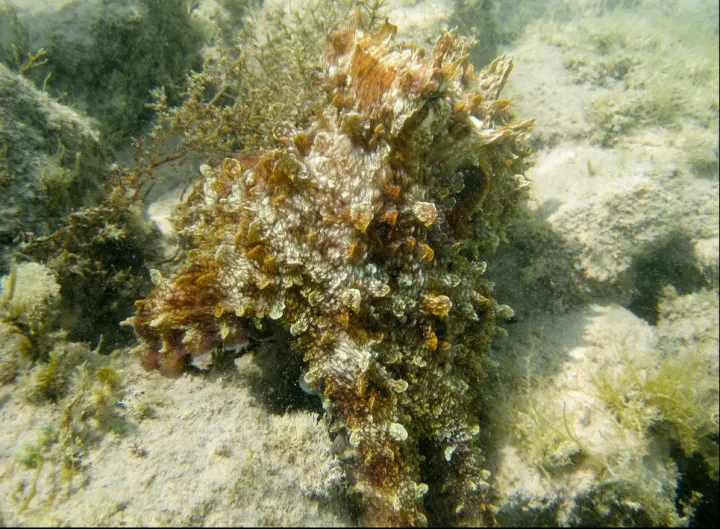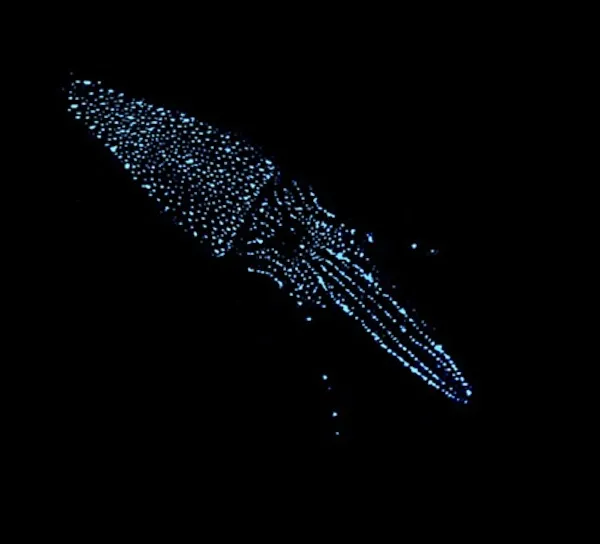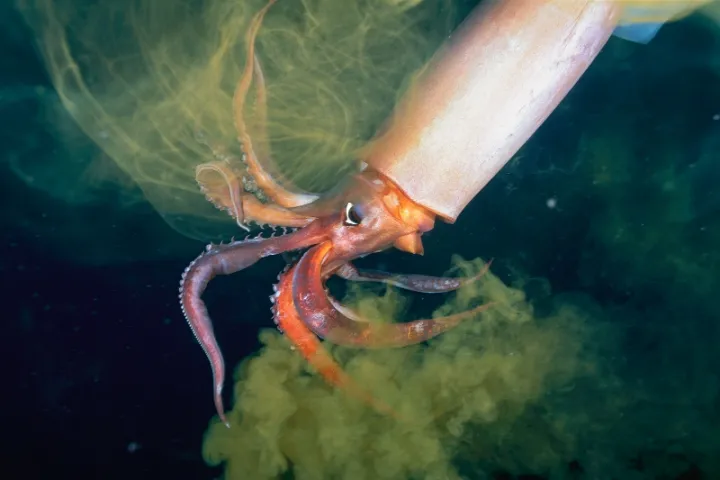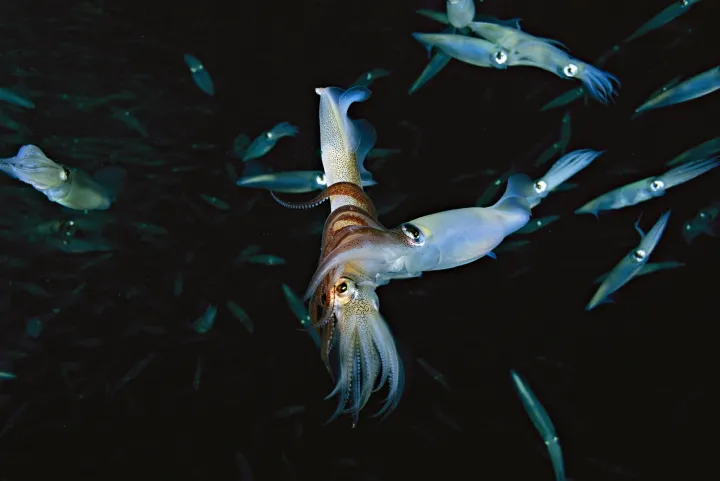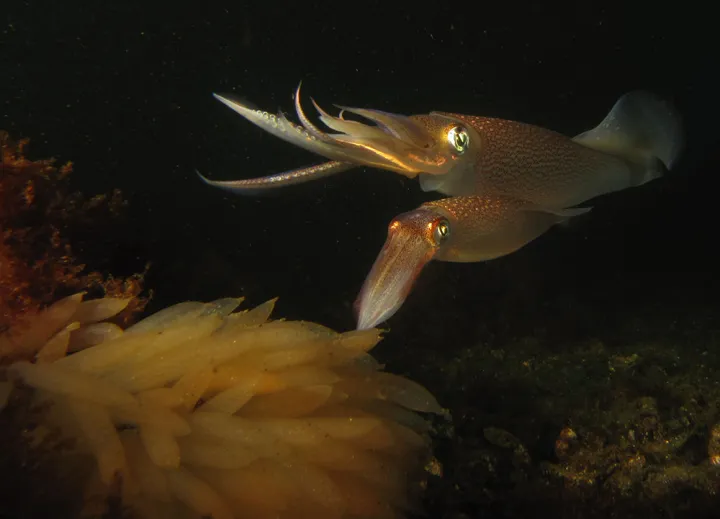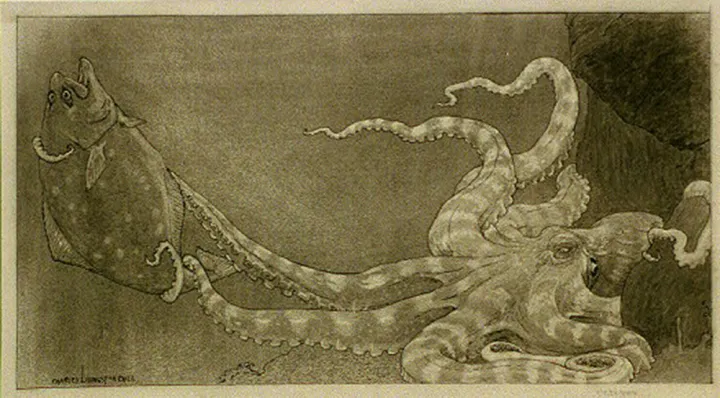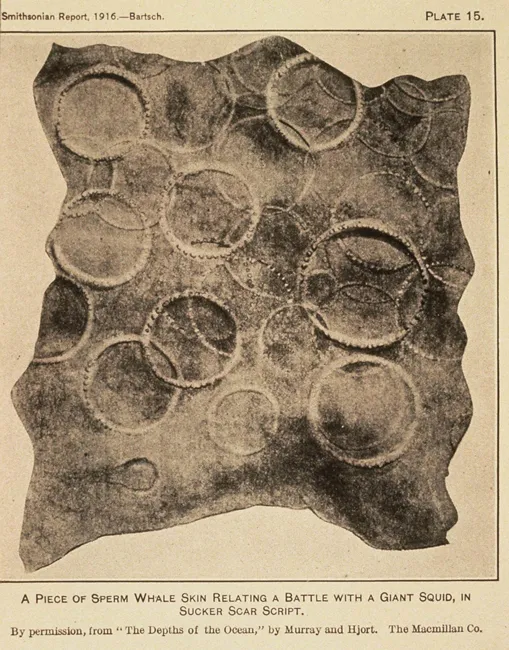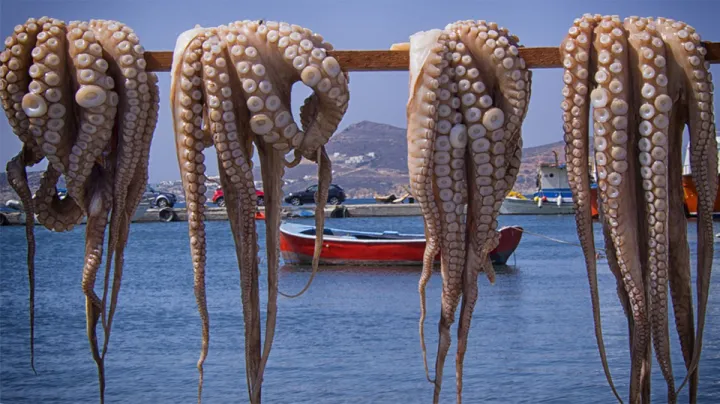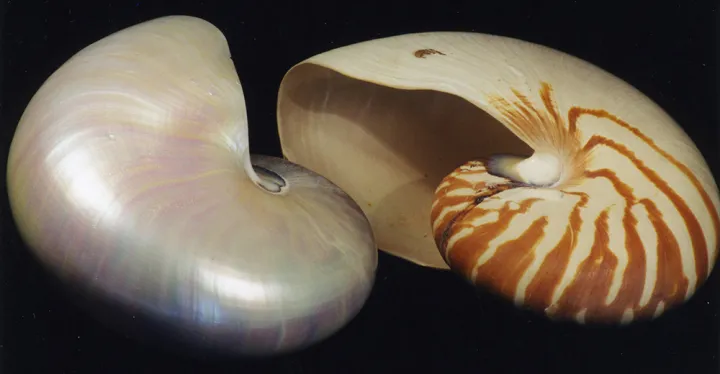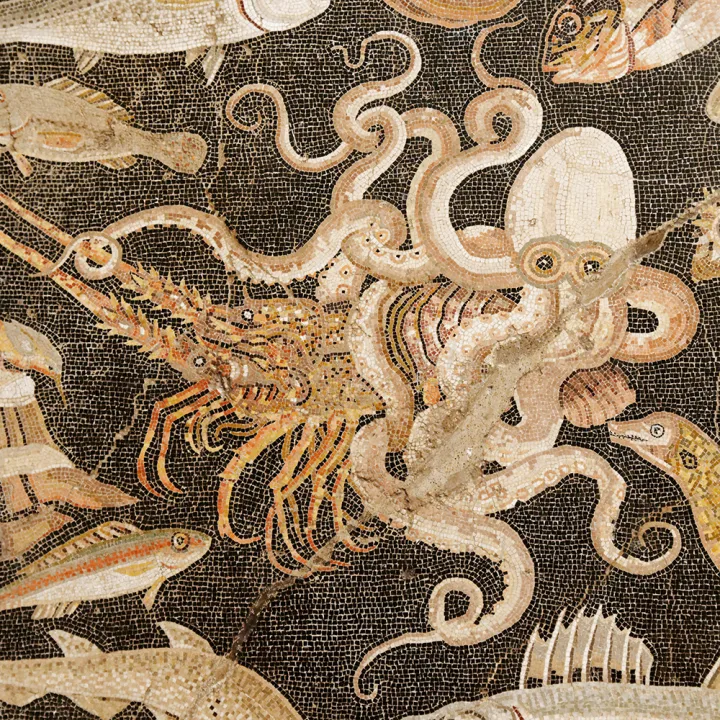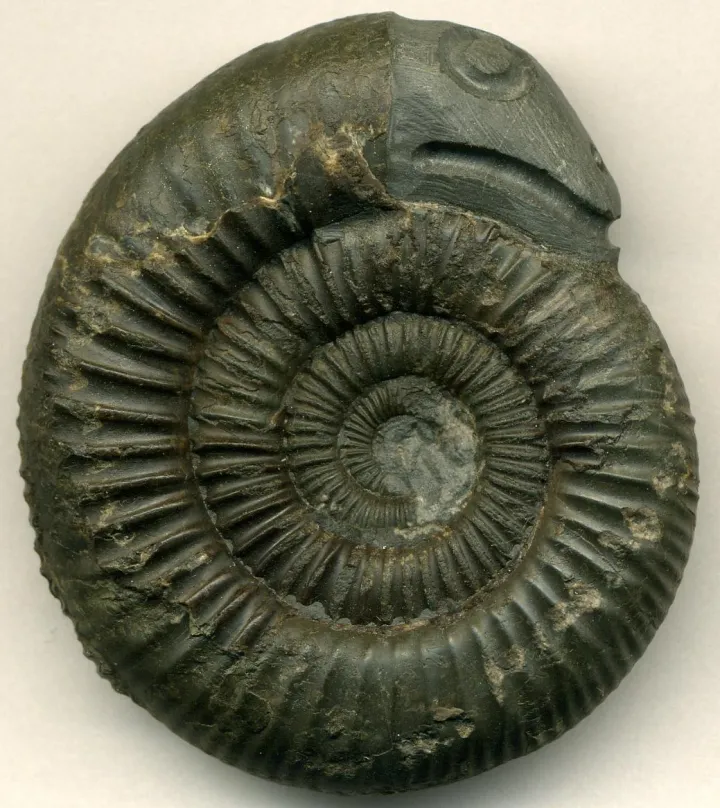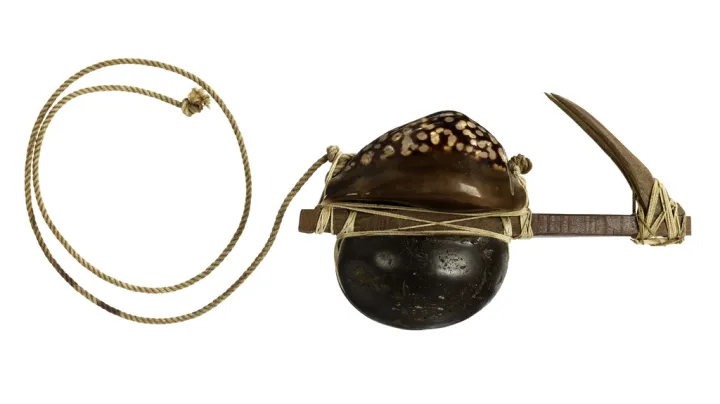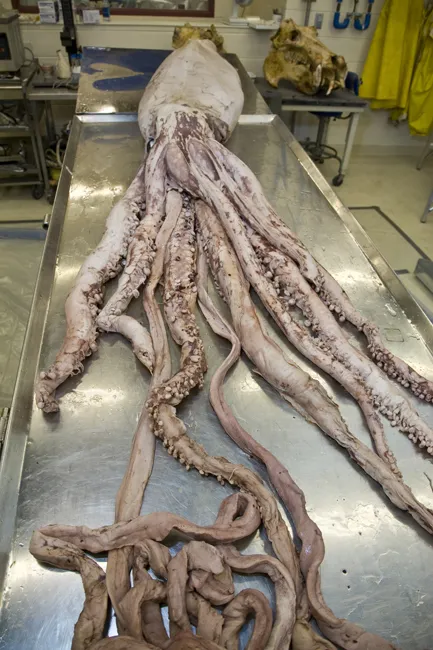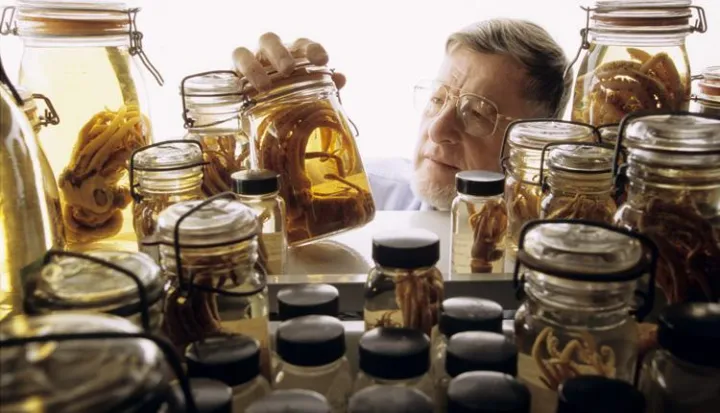
Octopuses, Squids, and Relatives
Introduction
A highly intelligent group of ocean dwelling creatures, the living cephalopods include the eight-armed octopuses, the ten-armed squids and cuttlefishes, and the shelled chambered nautiluses. Early in their evolution, cephalopods relied on the sturdy protection of shells, but over time many eventually lost the outer shell and instead relied on new adaptations like heightened intelligence, a talent for hiding, and strong, flexible arms. The largest—the giant squid—measures longer than a school bus, while the smallest ones—like the pygmy squid and California lilliput octopus—could sit on the tip of your finger. Cephalopods have long fascinated humans and were frequently mentioned by Aristotle, and this fascination shows no signs of diminishing today.
Anatomy, Diversity, and Evolution
Anatomy
Cephalopod literally means “head foot” in Greek, a reference to the way the cephalopod’s head connects to its many arms. The basic cephalopod body plan includes two eyes, a mantle, a funnel (also called a siphon), and at least eight arms. Some have hard, internal structures, like the cuttlebone in the cuttlefish and the pen in the squid, that evolved from the hard, outer shells of their ancestors, but in many octopuses the hard structure is completely lost. Only the chambered nautiluses have an external shell.
Arms, Tentacles, and Suckers
Octopus have eight arms while squid and cuttlefish have eight arms plus two other specialized arms, called tentacles. The tentacles are adapted to snatch prey from farther away through their ability to extend and retract. Both the arms and tentacles are equipped with powerful suckers that can function like suction cups. The suckers in some squids are transformed into sharp hooks to better grasp their prey, making squid a formidable underwater predator. The sucker rings of squids are composed of "suckerin" proteins that are similar in strength and structure to the protein found in spider’s silk.
With eight sucker lined arms and in some cases a pair of tentacles, a cephalopod can maintain a pretty tight grip. But how a cephalopod maintains that grip differs between squid and octopus. Squid use their suckers primarily for grabbing food. The cup-shaped sucker connects to the squid arm or tentacle via a thin stalk. Once the stiff, circular surface of the sucker comes in contact with the prey, a tug from the stalk decreases the pressure inside the sucker cavity, creating a sticky seal.
An octopus is a bit more dexterous than a squid, and uses its arms for a variety of tasks including walking and handling objects. Upon coming in contact with an object, like a tasty crab or rocky ledge, the sucker surface creates a seal with the object. Trapped within the sucker cavity, the water has nowhere to go as the sucker muscles contract. The muscle contraction causes water pressure within the sucker cavity to drop and the higher pressure of the surrounding open ocean forces the sucker surface against its chosen target, creating a strong hold. Inspired by the strength and suction mechanism of octopus suckers, scientists are using them as models for medical adhesives and attachment in robots.
The nautilus boasts an amazing 90 plus arms. These arms lack suckers but are lined with sticky grooves that help them grab prey.
Sight
Cephalopods are famous for their eyes. In some cephalopods the eyes are as complex as the human eye, and the eye of the giant squid is enormous. Most cephalopod eyes, like human eyes, contain an iris, pupil, lens, and in some cases, a cornea. Octopus, squid, cuttlefish, and nautilus all have differently shaped pupils— an octopus has a rectangular pupil, a cuttlefish has a w-shaped pupil, and a squid’s pupil is circular. Only the nautilus has a comparatively basic eye anatomy, relying on a pinhole pupil without a lens. They are able to dilate and constrict their pupils in varying light intensities and can probably distinguish very simple visual cues.
The rest of the cephalopods have complicated eyes. Even more remarkably, the complex eyes of humans and cephalopods are surprisingly similar in design considering the two evolved independently. A study by scientists at the Nagahama Institute of Bio-Science and Technology found that this similarity is due to one shared gene, Pax6, traced back to our last common ancestor, more than 500 million years ago. The gene is considered a master control gene—meaning it orchestrates how to make an eye (like an instruction manual) rather than constructing the individual building blocks.
Despite the complexity of their eyes, cephalopods are most likely colorblind. The ability to see color relies on specialized receptor cells. In animals and humans these cells are called cones, a distinction from the light sensitive cells called rods. Humans have three different types of cones: one that detects red wavelengths of light, one that detects blue, and one that detects green. In combination, these cones allow us to see a wide breadth of color hues. But cephalopods only have one type of photoreceptor cell, rendering it colorblind.
Or perhaps not! A recent study suggests that the strange shape of their pupils may allow some cephalopods to distinguish colors in a unique way. The unusual shape may act somewhat like a prism, scattering the various colors that make up white light into their individual wavelengths. Once the light has been divided, a cephalopod can then focus the individual colors onto its light-sensitive retina by a subtle change in the distance between the lens and retina. This method would take quite a bit of processing power compared to a multi-cone eye and can help explain why a cephalopod has such a large brain.
Cuttlefish eyes are especially notable among cephalopods. Cuttlefish are the most talented at discerning differences in polarized light, a feat that human eyes are unable to accomplish (humans perceive polarized light as a glare). For animals that can see it, polarization adds an extra dimension to an image, similar to the addition of color to a black and white photo. Natural light from the sun, or an incandescent light bulb, is unpolarized, meaning its energy radiates in all directions. But when light reflects off of a surface the light energy may be stripped down to only one direction—this is polarized light. The angle of polarized light varies depending on the surface it bounces off of—this is what a cuttlefish can discern. A cuttlefish can look at polarized light and detect within one degree the difference in that light’s energy direction.
Propulsion and Movement
A cephalopod gets around by using several different methods. In general, they use jet propulsion—strong muscles fill the mantle expel water from the mantle cavity through the funnel and propel the animal in the opposite direction. Bottom-dwelling octopuses usually use jet propulsion only as a means of escape, instead relying on their arms to walk across the sea floor—a few species even walk on two arms. A 2005 study found that the coconut octopus and the algae octopus tiptoe backward on two arms, a method that allows them to maintain their cryptic camouflage while crawling. For hovering, cephalopods have a couple of different strategies. Cuttlefish and a few squid species either undulate their fins to hover. Others produce and store an ammonium-based chemical that makes them neutrally buoyant.
The nautilus has a specialized system for movement and buoyancy that takes advantage of the compressible nature of gas. Within the shell of a nautilus are chambers of gas that it uses like a flotation device. The nautilus’ buoyancy is dependent upon a consistent volume of the gas within the shell, which becomes a bit tricky when you consider that at deeper depths the surrounding ocean pressure squeezes the gas pocket and at shallower depths it lets the gas expand. But the nautilus uses its chambered shell like a submarine’s ballast system to pass fluid and gas between the chambers to adjust the internal shell pressure and keep the gas a consistent volume as it swims between varying ocean depths.
Named for its visual likeness to the true nautilus, the paper nautilus or argonaut is actually an octopus, and the females live in a paper-thin structure. A female argonaut secretes an egg case that not only looks like a nautilus shell but also is used to help with buoyancy. At the ocean surface the octopus traps air within its papery shell and then propels itself underwater. At a certain depth, the compressed air pocket counterbalances the octopus’ weight, rendering it neutrally buoyant. The uncanny similarity between the argonaut egg casing and the nautilus’ shell indicate it may be an example of convergent evolution.
Circulatory System
Cephalopods have a lot of heart—three hearts to be exact. The two branchial hearts push oxygen-depleted blood through the gills while the systemic heart pumps the oxygenated blood throughout the body.
For cephalopods, the term “blue bloods” takes a more literal meaning than the medieval reference to nobility—their blood is actually blue. While humans and other animals rely on an iron-based oxygen transport system, cephalopods evolved a copper-based system, which is the source of the blue color (similar to horseshoe crabs). The copper-based molecule in a cephalopod's blood is called hemocyanin, which binds to oxygen to carry it throughout the body and power muscles. It has a significantly lower oxygen binding power when compared to iron-based hemoglobin, though a study of an Antarctic octopus, Pareledone charcoti, suggests the hemocyanin system helps cephalopods maintain efficient oxygen transport in environments of varying temperature and oxygen level. Hemocyanin is most efficient in cold water but loses its hold on oxygen in more acidic water suggesting that as oceans become warmer and more acidic due to climate change, cephalopods may struggle to circulate enough oxygen through their bloodstream.
The nautilus often encounters areas of low oxygen when it travels to depths of around 2,300 feet (700 m) and will lower its metabolic rate and siphon off small amounts of oxygen from its chambered shells in order to survive. It is also highly efficient at jet propulsion, more so than even the squid, and is able to use up to 75 percent of the energy it transfers to the water to move. This becomes highly advantageous when conserving oxygen is important.
Diversity
The cephalopods are a diverse class of mollusks (a group that also includes snails and bivalves) that emerged during an explosion of animal diversity in the oceans during the Cambrian period, over 500 million years ago (mya). Today, scientists divide the living cephalopods into three groups, called superorders. However, many details of cephalopod evolutionary classification continue to change as scientists find new clues from genetic testing and newly discovered fossils. Below we’ve outlined the three major superorders with some of the groups they contain according to the latest information.
Octopodiforms- The eight-armed cephalopods
- Octopus - There are roughly 300 species of octopuses swimming around in the ocean today, though the exact number is continuously changing as new species are discovered. During NOAA’s 2016 Okeanos mission scientists discovered the “Casper” octopus in the central Pacific Ocean in waters around 13,000 feet (4,000 meters) deep. Most octopuses spend the majority of their time living on the ocean floor. They are also solitary creatures and prefer to live alone in a den, however, the gloomy octopus is an exception and will congregate in underwater cities like the ones researchers nicknamed Octlantis and Octopolis. Most people are familiar with octopuses in the Incirrata group. They have soft bodies and no internal shell (or in some species two small rods made of cartilage), which allows them to squeeze their bodies through unimaginably tight spaces. The Cirrata, like the dumbo octopus, are deep-sea dwellers and have an internal cartilage shell, two fins on the sides of the body, and finger-like strands between their suckers called cirri.
- Vampire "Squid" (Vampyroteuthis infernalis)- Contrary to its name, the vampire squid is actually more closely related to the octopuses. Although its name translates to “the vampire squid from hell,” these cephalopods are far from dangerous, as they actually eat drifting particles called “marine snow” with two, thread-like filaments (that are modified arms). Like many deep-sea dwellers, their bodies are covered with light organs, and they can turn almost inside out by wrapping the arms around the body when they are disturbed. Their internal shell has evolved into a thin, broad plate similar to a squid's pen.
Decapodiforms- The ten-armed cephalopods
- Cuttlefish - More than 90 species of cuttlefish live in tropical and temperate waters off of Europe, Asia, Africa and Australia. They are predominantly seafloor dwellers and can be found in sandy, muddy or rocky habitats. While most species live between seven and 800 feet (2 and 250 meters) a few can survive at depths near 3,300 feet (1000 meters). They rely on a cuttlebone—an internal, modified calcareous shell with several chambers that help the cuttlefish maintain buoyancy. Scientists once believed cuttlefish were a completely separate lineage from other ten-armed cephalopods, however, recent genetic studies show that cuttlefish are evolutionarily among the groups of squid.
- Squid – The squids are divided into quite a few groups, with over 300 species worldwide. Some live in shallow waters while others travel to depths over 16,000 feet (5,000 meters). While most squids tend to live solitary lives, others congregate in schools of millions. Many squids are voracious predators. The Humboldt squid is a particularly fearsome predator that uses the toothed sucker rings to grab its prey. Squids have a stiff support structure called a pen (also called a gladius) that runs the length of the mantle and is made of chitin. The giant squid is the largest cephalopod, the longest ever recorded measured almost 43 feet (13 meters) long.
- Ram’s Horn Squid - The ram’s horn squid is the only living cephalopod within the spirula family, which is unique because of the internal, coiled shell that is collected by beachcombers. The animal lives between 1,000 and 5,700 feet (300 and 1,750 meters) in tropical and subtropical waters around the globe. A large light organ sits at the end of its body, though its function remains a mystery. Also mysterious is how it is related to the other squids.
Nautiloids-
- Nautilus - The only representatives of the early, shelled cephalopods that still exist today are Nautilus and the closely related Allonautilus (for simplicity here, they will both be collectively referred to as nautiluses). Nautiluses live in an external, coiled shell. The shell has many chambers, and as the nautilus grows it adds sequentially larger chambers. The largest and newest chamber is where the animal lives and the smaller chambers are used like submarine ballast tanks to regulate buoyancy. A newly hatched nautilus will only have four chambers but by the time they are adults they average around 30. There are seven recognized species within the nautilus family. They live in the southwestern Pacific Ocean, the Philippines, Indonesia and around Australia where they eat crab, shrimp, fish and the bodies of dead animals. High demand for nautilus shells in the shell and jewelry trade is causing concern over possible extinction. The crusty nautilus species was observed alive in 2015 for the first time in 30 years.
Evolution
Cephalopod Ancestors
While today’s cephalopods are most notable for their many arms and soft bodies, ancient cephalopods are mostly known from their shells because they are well preserved as fossils. Like the living nautilus, a fossil cephalopod shell has two distinguishing characteristics: a series of chambers divided by walls but connected by an internal tube. The barriers that separate the chambers are called septa and the internal tissue tube is called the siphuncle.
There are many more species of fossil cephalopods (17,000) than living ones (about 800) and some of the most important groups in the past have no living descendants. The earliest ancestors of today’s cephalopods appear in the fossil record around 530 mya, at a time of intense animal diversification during the Early Cambrian. Early cephalopods probably diverged from the monoplacophorans, a group of bottom-dwelling molluscs with tall, slightly curved, conical shells. The first of these early cephalopod ancestors is likely Tannuella, a mollusk with a chambered shell. However, the first confirmed cephalopod fossil is the Plectronoceras, noted by the presence of a siphuncle used for control of buoyancy. It is likely the acquisition of buoyancy that spurred diversification from these ancestral molluscs, since cephalopods were freed from a bottom-dwelling existence and could explore the open water column.
By the Ordovician, a period that began roughly 500 mya, a great diversity of cephalopod shells emerged. The stout, slightly curved shell shapes of the late Cambrian evolved into a variety of shapes that included coils, straight cones and domes. These shapes added benefits that expanded the cephalopod’s habitat from its ancestral shallow and warm waters.
Throughout much of the cephalopod's ancestry, the coiled shell evolved time and time again from a straight shell. A coiled shape strengthens the shell, increases maneuverability, increases the ability to cut through the water, and lowers the energy required to maintain buoyancy. Cephalopods dominated the seas for roughly 360 million years, and it wasn’t until the end of the Cretaceous at around 66 mya that fishes and marine mammals started to take over. The sluggish and armored cephalopods were likely no match for the new, swift swimmers. Not only were they competing for the same food sources, they were also likely a great snack. These fast swimmers flourished following the loss of dinosaurs during the KT mass extinction roughly 66 mya. Remarkably, coiled cephalopods in the nautiloid group survived the extinction, but the coiled ammonites did not fare so well. Some scientists argue that the acidic ocean waters following the extinction-causing meteor crash dissolved the delicate shells of baby ammonites that lived near the ocean surface, and the deeper dwelling cephalopods remained out of harms way. Today only eight species of cephalopods with coiled shells remain – the seven nautilus species and the ram’s horn squid.
With a lineage that extends to around 530 mya, it should be no surprise that the cephalopod family tree is pretty complicated. There are so many lineages and types of fossils that even cephalopod specialists often debate how they are related. Below, are a few of the best-known groups of ancient cephalopods.
The Nautiloids
The Nautiloids are one of the oldest groups of cephalopods, emerging at the end of the Cambrian roughly 500 mya. Throughout time, over 10,000 different species swam in the ocean, though today only the seven species of chambered nautiluses remain. Though the earliest nautiloids had straight shells, by the Ordovician, which began roughly 500 mya, their shells began to diversify, some becoming gently curved and others coiling. One way scientists distinguish the nautiloid fossils from their coiled cousins the ammonoids by looking at the siphuncle. In the nautiloids it is found directly down the middle of the chambers while in the ammonoids it hugs the outer shell wall.
The Ammonoids
Ammonoids are a group of extinct, coiled cephalopods that swam in the ocean between 420 and 66 mya between the Devonian and Cretaceous. The name ammonite comes from the Greek reference to the Egyptian god Amun, whose head was framed by spiraling ram’s horns. Some were as small as a thumbnail while the largest measured over eight feet (2.5 meters) in diameter, taller than the average, grown man. Ammonoids also differed from the nautiloids in that the septa dividing the shell chamber joined the outer shell wall in intricate, undulating edges. The septa-shell edge is called a suture, and as the ammonoids evolved the suture became increasingly intricate. This complexity may have helped with buoyancy control, while the more basic sutures of early ammonoids helped withstand the pressure of deep water. It is possible that early ammonoids lived in deep water and over time they moved into shallower waters.
The Belemnites
The belemnites swam in the ocean from the end of the Triassic to the Cretaceous roughly 245 to 66 mya and are one of the more studied straight-shelled cephalopods. They are also the fossil group most closely related to today’s squid and octopus. Based upon a few, rare soft-body fossils, they were squid-like and relied on jet-propulsion, with a straight internal shell and a pair of triangular fins. However, most of what we know about them comes from their shells—most belemnites had a solid tip beyond the chambered shell called a rostrum that was easily fossilized. Belemnites were tasty meals for sharks and icthyosaurs. Many shark fossils contain the arm hooks of belemnites in their stomachs, but the noticeably absent rostrum is presumed to be too difficult to digest and most likely was regurgitated.
Behavior and Ecology
Behavior
Intelligence
Octopus are famous for their sophisticated intelligence; some scientists even argue that cephalopods were the first intelligent beings on the planet. They are able to untie knots, open jars, and toddler proof cases, and are generally expert escape artists. There is increasing evidence that cephalopods have unique personalities—one octopus may be shy and reclusive, another curious and playful, or possibly mischievous and cranky. Perhaps, being defenseless, with soft bodies and living in a competitive environment with stronger, more agile bony fish led them to evolve especially sharp minds for problem-solving.
Intelligence requires big brains. A cephalopod brain is divided into many different sections called lobes. The squid Loligo has at least 30 different lobes. The lobes are specialized centers that, among other things, process information from the eyes, control camouflage, and store memories. Though structured similarly to other mollusks, a cephalopod nervous system far surpasses the nervous systems of their closest molluscan relatives—the California sea slug has about 18,000 neurons while the common octopus, Octopus vulgaris, has roughly 200 million neurons in its brain. Humans have many more, just under 100 billion, but a cephalopod is on par with dogs and some monkeys since they also carry about two-thirds of their neurons in their arms, not their head. Unlike humans and other mammals, the cephalopod brain will grow one and a half times its original size from the moment of birth to adulthood.
With intelligence comes the ability to learn. Scientists first realized cephalopods had a talent for learning after the publication of a groundbreaking study by a German researcher named Jakob von Uexkull in 1905. Uexkull starved a group of octopuses for fifteen days and then presented them with hermit crabs carrying anemones on their shells. The famished octopuses readily attacked the hermit crabs, though after a few stings from the anemones they soon avoided the crabs altogether. It was clear octopuses were cleverer than once believed and, as a result, scientists in the early 1900s began testing the limits of a cephalopod’s learning capacity.
Early studies found an octopus can be trained to perform specific behaviors using food rewards and shock punishments, showing they are capable of making associations. When presented with a foreign but harmless object they will initially explore and investigate, but after consecutive introductions, they quickly lose interest, a sign they remember the object and its now unremarkable nature.
Surprisingly, though, octopuses are not the best when it comes to tackling mazes—they fail to even remember a simple sequence of turns. However, in one experiment, the species Octopus maya quickly learned whether to take a right or left in a simple “T” maze to escape the dry maze and find their reward—the reprieve of a seawater tank. Levers are also tricky for octopuses and, for the most part, tests trying to teach octopuses to feed themselves using a lever mechanism have been unsuccessful.
It may come as a bit of a surprise that although they are reclusive and solitary creatures, octopuses may be able to learn from one another. In a 1992 study, scientists trained a group of octopuses to discriminate between two colored balls. Choosing a red ball elicited a tasty snack while choosing a white ball elicited an unpleasant shock. As this group of octopuses learned to associate color with reward and punishment, a second group of octopuses was allowed to observe from separate tanks. Next, these observers were given the choice—red or white. Without reward or punishment, the second group chose the red ball more quickly than the initial group.
Playing behavior is also attributed to intelligent organisms like mammals and some birds, but recent studies suggest octopuses may also like to have a little fun. A 1999 study at the Seattle Aquarium found that two of ten octopuses squirted water at weighted pill bottles, pushing the bottles against a filter current. After waiting for them to float back the octopuses squirted them again, almost like bouncing a basketball. A 2006 study suggested that octopuses will play with blocks as well.
Masters of Disguise
Sometimes referred to as the chameleons of the sea, a cephalopod can change the color and texture of its skin in the blink of an eye. Some use this skill to blend into their environment as masters of disguise, while others purposefully stand out with a flashy display. They change texture by controlling the size of projections on their skin (called papillae), creating surfaces ranging from small bumps to tall spikes. A 2018 study on cuttlefish found that once the papillae extend they become locked in place, enabling the cuttlefish to effortlessly hold their textured disguise while expending minimal energy. The color transformations are made possible by thousands of pigment-filled cells that dot the entire body, called chromatophores.
Within each chromatophore is an elastic, pigment-filled sac that is connected and controlled by several muscles and nerves. When the muscles contract the sack expands, revealing vibrant pigments—reds, browns, and yellows. When the muscles relax, the sack shrinks back down, hiding the pigment. Some cephalopods also have iridophores and leucophores, which add to the complexity of the skin’s color. The iridophores lie directly beneath the chromatophores and are responsible for displays of metallic greens, blues, gold, and silver. Leucophores, also known as “white spots,” scatter and reflect all light from the environment and are believed to aid in camouflage.
In combination, these color and texture changing techniques allow a cephalopod to mimic almost any background. Experiments by Roger Hanlon show cuttlefish expertly mimicking mottled textures, stripes, spots, and a black and white checkerboard!
Certain cephalopods have even mastered the ability to impersonate other animals, a self-defense tactic called mimicry. The mimic octopus is the pinnacle of shape-shifting wizardry. It appears to imitate up to 15 different animals (that we know of). Faced with a pesky damselfish it buries six of its arms in the sand leaving just two strategically placed and colored to look like the venomous banded sea snake (a predator of the fish). It can also cruise along the sand like a flat, banded sole fish or swim up in the water column like the venomous, spiny lionfish. The pharaoh cuttlefish’s chosen disguise is just as impressive—it can mimic the color, behavior and shape of a hermit crab.
Bioluminescence
ome cephalopods have one more trick up their sleeves when changing color. It’s called bioluminescence, which is the creation of light in specialized light organs called photophores. Light is created through a chemical reaction that produces light energy in the body of the animal, similar to how fireflies flash on a hot summer night. A catalyst called luciferase sets off the light producing substance called luciferin. The result is an eerie glow, startling flash, or syncopated blinking.
Bioluminescence serves more than just a pretty display. The concentration of photophores on the bottom side of some squid suggests the light is used as a camouflage technique called counterillumination; the bright light protects the squid from lurking predators below by allowing it to blend in with light coming from the surface of the water. But for the cephalopods that want to stand out, light is used to lure prey or flash as a warning for predators. The dazzling light displays of the firefly squid during mating season off the coast of Japan are quite the sight to see at night, though scientists are unclear whether the purpose of the light is to attract mates, deter predators, or something yet to be discovered.
One of the most exciting light displays is performed by the vampire squid. Deep ocean dwellers, vampire squid rely on three types of light organs. Each of the eight arms is tipped with several simple light organs, tiny photophores dot the skin, and a third, more complex pair of light organs with photoreceptors sit near the fins. When startled, luminescent clouds of mucus are emitted from the arm-tip light organs, leading scientists to think the glowing display is a defense mechanism.
While some cephalopods, like the vampire squid, are able to produce light on their own, for others lighting up requires a bit of help. The bobtail squid relies on a bacterium called Vibrio fischeri, and will selectively allow this bacterium to grow within its photophores. At birth, a young bobtail squid lacks the bioluminescent bacteria and must find the light producing microbes in the water column. At this stage of life, the squid’s light organ is not fully developed but small hairs along the photophore sweep the bacteria closer, and a molecular deterrent prohibits all bacteria except Vibrio fischeri from entering. Once one bacterium successfully enters the photophore it multiplies by the hundreds of thousands, a colonization that spurs the full development of the photophore. Without the bacteria the bobtail squid’s photophore will not develop, rendering the light organ useless as a cloaking device. Vibrio fischeri is a common bioluminescence partner with some other cephalopods that owe their glowing skills to the microbe.
Inking
“When the Sepia is frightened and in terror, it produces this blackness and muddiness in the water, as it were a shield held in front of the body.”—Aristotle, The History of Animals, Book IV (ca. 350 BC). Translated by Arthur Leslie Peck and Edward Seymour Forster. Aristotle XII: Parts of Animals Movement of Animals, Progression of Animals (1937).
In a stressful situation, a cephalopod has one final defense tactic. Almost all cephalopods have an ink sac, a bladder that can suddenly release a plume of dense, black ink. The ink is a mix of two secretions—a melanin-based chemical from the ink gland that gives it the dark hue and a thick mucus from the animal’s funnel organ. Another compound in the ink, called tyrosinase, is a potent irritant that can disrupt a predator’s smell and taste, as well as cause blindness. When startled or attacked by a predator the ink jet works like a smokescreen, a distraction, or a cephalopod look-a-like that the predator attacks instead which allows the real cephalopod to make a quick escape.
The ink can also act as a warning cue to other cephalopods. In the presence of ink the California market squid will begin to swim, and the Caribbean reef squid will initiate camouflage coloring. The Japanese pygmy squid has figured out how to use ink to hunt for shrimp, rather than just hide from predators. It squirts a few quick puffs in the direction of the shrimp and then darts through the ink to grab its meal. The ink is potentially used as a way to both hide from the prey and to distract the shrimp from noticing the incoming attack.
Reproduction
For most cephalopods, sex is a once in a lifetime event—both the male and female die shortly after mating. A male sometimes initiates the interaction with a courtship display meant to attract and woo the female, though for most octopuses there is little foreplay. If successful, the male will use his hectocotylus, a specialized arm, to deposit sperm packets called spermatophores on or in the female.
The story of how the name hectocotylus came to be is a tale of mistaken identity. In 1829, the famous naturalist George Cuvier identified an odd “organism” within the mantle of a female paper nautilus (which, to make matters even more confusing is, in fact, an octopus) and thought it was a new parasitic worm which he called the hectocotylus. Turns out, it was actually a male cephalopod arm, but the name stuck. In the paper nautilus, the hectocotylus detaches completely during sex and remains inside the female—this is what Cuvier mistook as a worm. Fertilization varies from species to species and in some cases the female holds on to the hectocotylus in a specialized pouch and fertilizes the eggs as she lays them.
In some squid and cuttlefish, mating occurs in mass gatherings and the males compete for access to the female as she spawns. In the European squid, Loligo vulgaris, smaller males will skirt around the edges of the spawning ground and display patterns similar to a female, rather than challenge the dominant male. Once a female begins to spawn, a small male will dart in and quickly mate with her, a behavior that has earned them the name “sneaker” males.
If a female octopus lives near the ocean floor, once her eggs are fertilized, she will scout out a shelter to lay her eggs and attach them to the ceiling or walls in long strings. She’ll forgo eating and instead spend her time fanning the eggs with water to keep them clean and protect them from predators. While most octopus mothers spend less than a few months watching over their brood, one deep-sea octopus, Graneledone boreopacifica, holds the record for the longest time spent watching over her eggs—over four and a half years! The long egg development time is most likely a response to the relatively cold environment of the deep sea. For some squids that live in the open ocean, the eggs are spawned in gelatinous masses that then drift within the water column. The discovery of a mass squid graveyard off the coast of California indicates that once the female squid successfully reproduce, they die and sink to the bottom of the ocean to over 3,300 feet (1,000 m) where they become food for deep-sea scavengers.
Upon hatching, the tiny, baby cephalopods become planktonic, meaning they live in the water column. Many hatchlings are already adept predators and will actively pursue prey. Little is known about the early life stages of specific species due to difficulties in identifying the very small young.
Ecology
In the Food Web
A cephalopod is a strategic and cunning predator. They’ve evolved to become proficient stalkers, ambushers, and masters of disguise. They also aren’t very picky—a cephalopod can eat anything (besides plants) from crustaceans to fish, bivalves, jellyfish, and even other cephalopods. Divers know that a telltale sign of an octopus den is a collection of empty crab shells littered on a rocky bottom.
Carnivorous predators, all cephalopods have evolved special tools to help eat their prey. They rely on a sharp beak that chops their prey into bite-size pieces. Inside the beak, a tongue-like radula is lined with tiny teeth which can push food down into the digestive tract or act like a drill to bore holes in shellfish. In many cephalopods, not just the notoriously deadly blue ringed octopus, a salivary gland produces a paralyzing toxin that immobilizes and digests prey upon being bitten. The cephalopod esophagus runs through the brain, requiring food to be sufficiently pulverized so it can fit through the narrow space. The digestive tract also includes a stomach, which further mashes the food, and a caecum where some nutrients are absorbed.
Often, cephalopods are voracious consumers. A study of the California two-spot octopus found that an 80 percent decline in the octopus population spurred a 500 percent explosion of their prey populations, gastropods (snails and slugs) and hermit crabs. In the English Channel, unseasonably warm waters in 1900 and again in 1950 caused an “octopus plague” in which Octopus vulgaris, an uncommon species in the area, became so abundant that they consumed much of the shellfish. The Western Evening Herald of Plymouth, United Kingdom wrote in 1899, “they have quite ruined the fisheries, and many men have laid up their boats in despair. They devour everything, even crabs, and lobsters, and oysters, and all shellfish.”
Some oceanic cephalopods participate in daily movements, called diel vertical migrations. The cover of night allows them to hunt at the surface without the threat of predators seeing them. Once the sun comes up they make their way down to deeper, darker water.
Although a formidable predator in its own right, the soft bodies of squid, octopus, and cuttlefish are delectable meals for other predators. Moray eels enjoy eating octopuses arm by arm and dolphins will toss and thrash an octopus against the water’s surface in an effort to stun them prior to eating. Birds also eat cephalopods. Albatrosses will plunge up to 32 feet (10 meters) deep to snatch a squid beneath the waves. Scientists often find the tough beaks of squid and octopus in the stomachs of sperm whales and seals. Sperm whales that wash ashore can even have large sucker scars along their body, indicating the whales engage in epic battles with giant squid while eating them.
Human Use and Conservation
Fisheries
People have enjoyed eating cephalopods since ancient times. According to Paul Bartsch, Curator of Mollusks at the Smithsonian Museum of National History in the early 1900s, the Greeks and Romans considered all kinds of octopus to be a delicacy. In Rome, they would stuff the cavity within the body full of spices, cut off the arms, and bake it in a pie. During preparation, chefs refused to use iron knives claiming that the metal left an unsavory taste and would instead use special bamboo knives. The Greeks, too, enjoyed octopus, and often sent one as a gift to parents the fifth day after a child was born, the naming day. One comedic Greek story tells the tale of Philoxenus of Cythera, a particularly greedy man. One night, Philoxenus desired an elaborate meal, which subsequently included a massive, three-foot octopus as its main dish. Upon consuming all eight arms by himself, the man fell ill and required the attention of a doctor. But the doctor’s prognosis was not good—Philoxenus was told he only had hours to live. Resigning himself to his fate, he decided to finish off the rest of the meal claiming, “he left nothing on the earth which seemed to him worthy of regret.”
In many places around the world, octopus, squid, and cuttlefish are common menu items at the dinner table. Over 4 million metric tons of cephalopods are fished from the ocean every year, the same weight as 27,000 adult whales. Squids make up a good chunk of the catch, accounting for about 75 percent of that total. In several areas like the Gulf of Thailand, evidence of squid fishing can even be seen from the international space station. Squid fishermen string hundreds of bright lights from their boats at night to attract plankton, a powerful lure for squid that follow their prey to the surface where they are then caught by the fisherman. But octopuses and cuttlefishes are also culinary favorites. A 2011 United Nations Food and Agriculture Organization report found that roughly 351,000 metric tons of octopus were fished the previous year, and in recent years cuttlefishes have had similar totals. Cephalopod ink itself is the featured ingredient in Italian risotto nero and Spanish arroz negro. In Asia where there is a prominent cephalopod fishery, the ink is also used in traditional medicine, having exhibited antimicrobial properties. There is also great interest in its use in anticancer drug development.
Cephalopods reproduce rapidly and so overfishing is often less of a problem than it is with finfishes. However, the giant cuttlefish (Sepia apama) experienced a significant decline in numbers during the 1990s. These cuttlefish are quite famous for their annual breeding aggregations off the coast of Australia in the Spencer Gulf, a phenomenon that attracts scientists, filmmakers, tourists, and fishermen. Cuttlefish meat is also a popular dish and although it is still unclear what is the exact cause of the population decline, exploitation of the easy to find cuttlefish is potentially a contributor. Local divers recall how in an area that once saw thousands of the cuttlefish, people are now thrilled to see a couple hundred. One 2008 study found a 57 percent reduction in the Spencer Gulf population between 2001 and 2008. Another 2013 South Australia Research and Development Institute report shows similar data. The Point Lowly spawning aggregation, also off the coast of Australia, went from 183,000 cuttlefish in 1999 to 18,530 in 2012. In 2014, cuttlefish fishing was banned from the area and there is hope that the stricter regulations will help them rebound.
Shell Trade
The pearly white inner shell of the nautilus, called the nacre, is an admired and sought-after material. The increased harvest of nautilus for their shells has caused concern among scientists. The United States imported roughly 579,000 shells between 2005 and 2008, mostly to make jewelry. The shells are sometimes molded into balls and marketed as Osmeña pearl (a reference to the Philippine Osmeña dynasty) and are popular materials for earrings, bracelets and necklaces. Nautilus population numbers are mostly unknown, and for now, scientists are relying on anecdotal information on fishing catches to estimate their decline.
Fishermen in the remote islands of the Philippines use dugout canoes and pull the nautilus traps up by hand. In the early 2000s on the Philippine island of Bohol, fishermen caught up to 200 nautilus a day, but now they may only pull up a few. When fishing dries up in one area the shell buyers move and the fishermen usually follow. Now scientists and governments are coordinating to try and save this ancient animal. An international proposal drafted by the U.S., India, Palau and Fiji urged the protection of nautiluses under the Convention of International Trade in Endangered Species (CITES), and in 2016 it was accepted. Starting in January 2017, the international trade of nautilus shells had to be accompanied by a CITES permit. A National Oceanic and Atmospheric Administration funded project is currently trying to find out how many of these animals are left in the waters of American Samoa and Fiji.
Cephalopods and Science
Embedded in the mantle of every cephalopod is large neuron called the giant axon. Up to a millimeter in diameter, it is visible to the naked eye, making it a prime candidate for scientific experimentation. Aided by this axon, in 1939, scientists Alan Hodgkin and Andrew Huxley made a monumental discovery about the mechanism of neuron signaling. The scientists were able to insert an electrode into the axon and record an action potential, the electrical impulse that is passed from one neuron to another like a baton in a relay race. The discovery was such a monumental leap in the field of neuroscience that the responsible scientists were awarded a Nobel prize for Physiology or Medicine.
Odd Genetics
A 2017 study found that evolution occurs in cephalopods differently than in any other organism (that we know of). In general, evolution occurs through a series of incremental changes in the DNA code—a mutation occurs in DNA, which then is transcribed in the instructional RNA, which then tells the cell how to build an altered protein. But cephalopods have found a way to hijack that system and instead edit the RNA. Since DNA codes for the RNA editing proteins, an RNA editing system requires that the underlying DNA remain consistent through time. That may put a wrench in previous estimates of the cephalopod’s evolutionary age. Combined with fossil data, scientists determine how old in geological time an organism is by looking at the number of mutations in a DNA sequence. If cephalopods use RNA editing instead, this aging system won’t work and ancestral lineages may need to be revised to place them in the proper timeframe. Next, researchers plan to dive into why cephalopods evolved such a unique system of adaptation.
Cultural Connections
Human fascination with cephalopods began thousands of years ago. Images of octopuses appear on pottery dated from 2000 BCE during the Minoan period and there’s even an Egyptian hieroglyphic in the shape of a squid.
For hundreds of years seafarers have regarded octopus and squid with trepidation, fear, and awe—feelings that inspired many stories, like 20,000 Leagues Under the Sea, that depict squid as terrifying beasts. Many other stories, movies, and artwork depict octopuses and squid as fearsome monsters. But most of the myths and legends are merely that—stories with little basis in fact. Today, characters like Dr. Octavius in “Spiderman” and Ursula in “The Little Mermaid” follow the evil monster tradition.
Fossilized cephalopod shells were quite a mystery to people during ancient times, and are the source of several fantastical tales. In the 600s, the town of Whitby in North Yorkshire, England believed ammonite fossils were snakes turned to stone, and artists often carved a snake head at the end of the shell. The town coat of arms includes three of these “snakestones.” The bullet shape of the belemnite rostrum caused the ancient Greeks to believe the fossils were thrown from the heavens in thunderstorms, a story that earned them the name “thunderbolts.” They also turn up in Greek folklore and are called “Devil’s fingers.”
In Greco-Roman times the ink of a cuttlefish was a popular medium for painting, drawing, and writing. Called sepia—the scientific name for cuttlefish—the coloring was a distinctive reddish-brown that could be diluted to create a wide range of brown hues. Some of the first paper photographs popularized in the 1860s had a similar color and the term was transferred to describe photographs as well. However, the photograph color was from the chemical degradation of albumen, an egg white base that binded with a silver solution, rather than actual cuttlefish ink. Today, the sepia filter is common in digital photo editing.
When it comes to sports traditions, hockey has a few of the most elaborate, one of which includes an octopus. In 1952, during the playoffs, two Red Wings fans threw an octopus onto the ice. Each tentacle represented one of the eight wins (two best-of-seven series) needed to secure the Stanley Cup, a feat the Red Wings went on to complete. Today, fans remember the “Legend of the Octopus” and continue to throw octopuses onto the ice during a game. Traditional etiquette requires that the octopus be boiled (to get rid of slime) and be thrown only after a Red Wing goal.
In the 1960s the Puget Sound Mudsharks dive club hosted an annual World Octopus Wrestling Championship in Tacoma, Washington. Divers would pry the giant Pacific octopuses from their lair and then take them to the beach to be weighed. Many people marveled at the calmness of the octopus while they were kept in aquariums on the beach. After the winner was named the octopuses were released back into the ocean.
Finally, is it octopi or octopuses—how do you know which one is correct? You may have noticed that throughout this website the plural of octopus is octopuses. Grammarians have been debating the plurality of octopus since the word emerged in the English language in the 1700s. The answer lies in the origin of the word, which stems from the Ancient Greek oktṓpous, not a Latin word as many mistakenly assume when they use the word octopi. As a Greek word, the plural should be octopodes, but as Merriam Webster points out, whenever a foreign word is assimilated into the English language it assumes the English plurality—so octopuses it is. Then again, using the word octopodes is technically also correct, but we don’t suggest whipping it out in casual conversation unless you wish to spur a grammatical debate. Avoiding the confusion altogether, some scientists refer to all eight armed cephalopods as octopods, reserving the term octopus for only those within the genus Octopus.
At the Smithsonian
Operation Calamari
Travel to the Smithsonian’s National Museum of Natural History Sant Ocean Hall and you will find the largest cephalopod species in the world. Two giant squid are displayed at the museum, the larger of the two measured 36 feet (11 meters) when alive and was probably about 2-3 years old when it became caught in a fisherman’s net off the coast of Spain. Transporting such a large specimen required the help of the U.S. Navy and the U.S. Air Force and even warranted a special code name—Operation Calamari. The squids are two of only about a dozen giant squids on display at museums around the globe.
Collections
The Smithsonian’s National Museum of Natural History has one of the most diverse collections of squids and octopuses found in the world. The National Cephalopod Collection totals about 200,000 preserved specimens that were collected from around the globe and includes the holotypes for 164 cephalopod species, of which 66 are squid species. Holotypes are the specimens that are used by scientists to formally describe and name a new species.
Additional Resources
Websites:
Tree of Life - Basic overview of cephalopods
University of California Museum of Paleontology- The Cephalopoda
The British Geological Society- Information about extinct cephalopods
The University of Michigan Museum of Zoology- Animal Diversity Web with background information on Cephalopoda
News Articles:
Curiouser and Curiouser--Octopus's Evolution Is Even Stranger Than Thought- Scientific American
Loving the Chambered Nautilus to Death- The New York Times
A Dolphin's Recipe for Octopus -The New York Times
Polarized Display Sheds Light on Octopus and Cuttlefish Vision-and Camouflage - Scientific American
Octlantis is a Just-Discovered Underwater City Engineered by Octopuses - Quartz
The Cuttlefish, a Master of Camouflage, Reveals a New Trick - The New York Times
Books:
20,000 Leagues Under the Sea- by Jules Verne
Kraken - by Wendy Williams
The Soul of an Octopus - by Sy Montgomery
Other Minds: The Octopus, the Sea, and the Deep Origins of Consciousness - by Peter Godfrey-Smith
Squid Empire - by Danna Staaf


